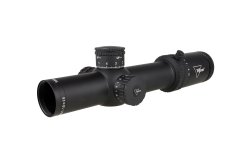
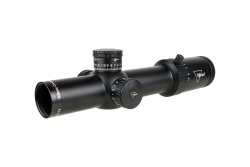
In the constantly growing market segment of Low Power Variable Optics (or LPVO) for dynamic use such as hunting on the move or IPSC/action, scopes with 1-10x magnification represent the new premier class after many models with 1-4x, 1-6x or 1-8x magnification. Many manufacturers/brands such as EOTech, Konus, Sightmark, SIG Sauer, Swampfox and Vortex are already involved here and now Trijicon is also participating in this trend. The Trijicon Credo 1-10x28, which weighs around 600 grams, has a 34-mm main tube and a reticle in the first focal plane illuminated in either green or red, each with five light intensity settings, with a dot in the center, outer circle segments and crosshair holding marks for fast target acquisition and point of impact corrections at different distances. The field of view is 38.87 to 3.9 m at 100 meters and the adjustment mechanisms can be operated in fine 0.1 MRAD clicks. The almost identical HX version of the new Credo 1-10x28 is designed for hunters and has ¼ MOA click adjustment mechanisms.
Trijicon Tenmile HX 5-25x50 FFP hunting riflescope
The reticle of the high-performance Trijicon Tenmile HX 5-25x50 hunting riflescope is also located in the first focal plane. This means that the size of the reticle changes in relation to the magnification, which enables reliable distance estimation using the reticle markings in MOA. An optional model with an illuminated reticle in the second focal plane is also available. As with the Credo, the illuminated reticle of the Tenmile HX 5-25x50 FFP has five settings of illumination intensity in either red or green. Weighing around 820 grams, the riflescope with a 30-mm main tube diameter and ¼ MOA click adjustment mechanism has a total adjustment range of 50 MOA in elevation and 40 MOA in windage. The field of view is 7.77 to 1.57 meters/100 meters. The Trijicon HX 5-25x50 with reticle in the second focal plane and ten intensity settings in red, which is lighter at around 725 grams, has a field of view of 6.7 to 1.3 meters/100 yards. For these riflescopes, Trijicon also offers customized Kenton Industries elevation adjustment turrets ("custom turrets") with bullet trajectory compensation tailored to the respective ammunition/loading.
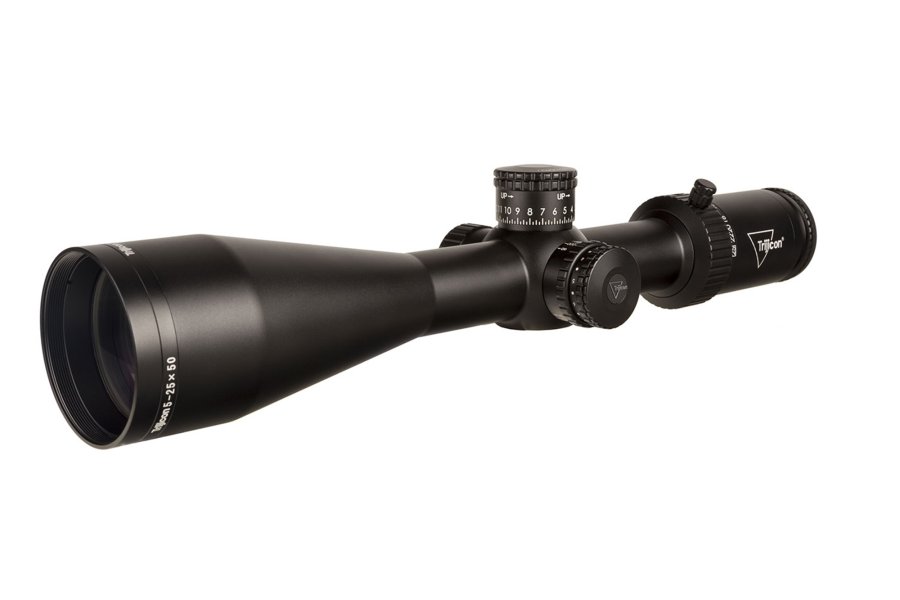
Aiming aids for fast shooting: Trijicon RMR HD & RCR
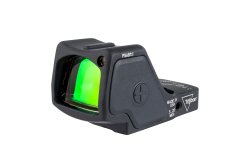
With the established RMR/RMR 2, Trijicon has always been one of the market leaders in the field of mini red dot sights for military/LE use. After all, the Trijicon RMR is the official pistol red dot sight of USSOCOM. Now the indestructible Trijicon RMR with 3.25 MOA and 1.0 MOA dot size is available in an improved HD version with features such as an enlarged window for even faster target acquisition and a "toploader" function for the CR2032 lithium battery. This means that the sight no longer has to be laboriously removed from the gun when the battery needs to be changed and the gun does not necessarily have to be re-sighted in. You can also choose between two reticle variants with a central dot and a central dot plus surrounding circle segments, and the automatic brightness adjustment and contrast can be individually regulated. Of course, the new RMR HD also has the same footprint as its RMR/RMR 2 predecessors, so that all the matching pistol slice interfaces, adapter plates and holsters can still be used.
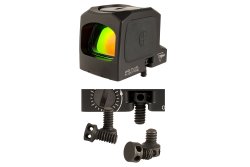
The recent Trijicon RCR now also offers a mini red dot sight with an enclosed housing ("Closed Emitter Mini Red Dot Sight"). This trend was certainly triggered by the Swedish pioneer Aimpoint with its ACRO model and many other manufacturers, such as Holosun or Steiner, have jumped on the bandwagon. The advantages over the dominant models with an open design and free-standing front lens, such as the Leupold DeltaPoint Pro or Trijicon RMR, are obvious. In these designs, the LED is protected in the rear part of the housing. However, its front is exposed, so that foreign bodies can get between the lens and the diode, preventing the reticle from being projected. Moisture can also collect on the front of the light-emitting diode, which can also impair the clear reproduction of the reticle.
To reliably prevent all of this, Aimpoint created the ACRO C-1/P-1 in 2018, with the second, significantly improved generation appearing three years later due to insufficient battery power. The Trijicon RCR, which weighs around 56 grams compared to the RMR (which weighs around 34 grams), is currently only available with a 3.25 MOA dot size and has 10 brightness settings, including three settings compatible with night vision technology and a "Super Bright" level. Due to their design, enclosed MRDSs cannot be attached to a rifle from above using screws like open emitter sights. Instead, they are mounted on the gun using special dovetailed adapter plates. The Trijicon RCR, on the other hand, is based on the identical RMR footprint and can be mounted on the gun using a patented screw system without special adapter plates.
It is not yet clear when the new Trijicon devices will find their way to Europe and at what prices.
More information on the new products can be found on the Trijicon website.


